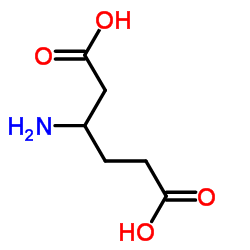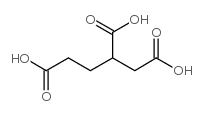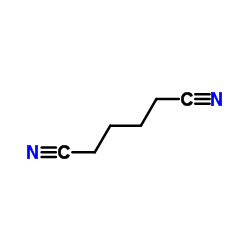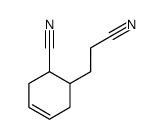E/Z-1,4-Dicyano-but-1-en
Modify Date: 2024-04-02 16:58:56

E/Z-1,4-Dicyano-but-1-en structure
|
Common Name | E/Z-1,4-Dicyano-but-1-en | ||
|---|---|---|---|---|
| CAS Number | 13042-02-9 | Molecular Weight | 106.125 | |
| Density | 1.0±0.1 g/cm3 | Boiling Point | 297.3±23.0 °C at 760 mmHg | |
| Molecular Formula | C6H6N2 | Melting Point | N/A | |
| MSDS | N/A | Flash Point | 151.6±16.5 °C | |
| Name | E/Z-1,4-Dicyano-but-1-en |
|---|---|
| Synonym | More Synonyms |
| Density | 1.0±0.1 g/cm3 |
|---|---|
| Boiling Point | 297.3±23.0 °C at 760 mmHg |
| Molecular Formula | C6H6N2 |
| Molecular Weight | 106.125 |
| Flash Point | 151.6±16.5 °C |
| Exact Mass | 106.053101 |
| PSA | 47.58000 |
| LogP | 0.00 |
| Vapour Pressure | 0.0±0.6 mmHg at 25°C |
| Index of Refraction | 1.463 |
Synonym: Section 2 - COMPOSITION, INFORMATION ON INGREDIENTS
Risk Phrases: 22 Section 3 - HAZARDS IDENTIFICATION EMERGENCY OVERVIEW
Harmful if swallowed. Potential Health Effects Eye: May cause eye irritation. Skin: May cause skin irritation. Ingestion: Harmful if swallowed. May cause irritation of the digestive tract. Inhalation: May cause respiratory tract irritation. Chronic: Not available. Section 4 - FIRST AID MEASURES Eyes: Flush eyes with plenty of water for at least 15 minutes, occasionally lifting the upper and lower eyelids. Get medical aid. Skin: Get medical aid. Flush skin with plenty of water for at least 15 minutes while removing contaminated clothing and shoes. Ingestion: Get medical aid. Wash mouth out with water. Inhalation: Remove from exposure and move to fresh air immediately. If not breathing, give artificial respiration. If breathing is difficult, give oxygen. Get medical aid. Notes to Physician: Section 5 - FIRE FIGHTING MEASURES General Information: As in any fire, wear a self-contained breathing apparatus in pressure-demand, MSHA/NIOSH (approved or equivalent), and full protective gear. Extinguishing Media: Use extinguishing media most appropriate for the surrounding fire. Section 6 - ACCIDENTAL RELEASE MEASURES General Information: Use proper personal protective equipment as indicated in Section 8. Spills/Leaks: Absorb spill with inert material (e.g. vermiculite, sand or earth), then place in suitable container. Section 7 - HANDLING and STORAGE Handling: Avoid breathing dust, vapor, mist, or gas. Avoid contact with skin and eyes. Use only in a chemical fume hood. Storage: Store in a cool, dry place. Store in a tightly closed container. Section 8 - EXPOSURE CONTROLS, PERSONAL PROTECTION Engineering Controls: Use adequate ventilation to keep airborne concentrations low. Exposure Limits CAS# 13042-02-9: Personal Protective Equipment Eyes: Not available. Skin: Wear appropriate protective gloves to prevent skin exposure. Clothing: Wear appropriate protective clothing to prevent skin exposure. Respirators: Follow the OSHA respirator regulations found in 29 CFR 1910.134 or European Standard EN 149. Use a NIOSH/MSHA or European Standard EN 149 approved respirator if exposure limits are exceeded or if irritation or other symptoms are experienced. Section 9 - PHYSICAL AND CHEMICAL PROPERTIES Physical State: Not available. Color: Not available. Odor: Not available. pH: Not available. Vapor Pressure: Not available. Viscosity: Not available. Boiling Point: Not available. Freezing/Melting Point: Not available. Autoignition Temperature: Not available. Flash Point: Not available. Explosion Limits, lower: Not available. Explosion Limits, upper: Not available. Decomposition Temperature: Solubility in water: Specific Gravity/Density: Molecular Formula: NC(CH2)2CH=CHCCN Molecular Weight: 106.13 Section 10 - STABILITY AND REACTIVITY Chemical Stability: Not available. Conditions to Avoid: Incompatible materials. Incompatibilities with Other Materials: Strong oxidizing agents. Hazardous Decomposition Products: Nitrogen oxides, carbon monoxide, carbon dioxide. Hazardous Polymerization: Has not been reported. Section 11 - TOXICOLOGICAL INFORMATION RTECS#: CAS# 13042-02-9: MP6747500 LD50/LC50: CAS# 13042-02-9: Oral, rat: LD50 = 380 mg/kg; Skin, rabbit: LD50 = >5010 mg/kg. Carcinogenicity: 2-Hexenedinitrile - Not listed by ACGIH, IARC, or NTP. Other: See actual entry in RTECS for complete information. Section 12 - ECOLOGICAL INFORMATION Section 13 - DISPOSAL CONSIDERATIONS Dispose of in a manner consistent with federal, state, and local regulations. Section 14 - TRANSPORT INFORMATION IATA Shipping Name: NITRILES, LIQUID, TOXIC, N.O.S.* Hazard Class: 6.1 UN Number: 3276 Packing Group: III IMO Shipping Name: NITRILES, TOXIC, N.O.S. Hazard Class: 6.1 UN Number: 3276 Packing Group: III RID/ADR Shipping Name: NITRILES, TOXIC, N.O.S. Hazard Class: 6.1 UN Number: 3276 Packing group: III Section 15 - REGULATORY INFORMATION European/International Regulations European Labeling in Accordance with EC Directives Hazard Symbols: XN Risk Phrases: R 22 Harmful if swallowed. Safety Phrases: WGK (Water Danger/Protection) CAS# 13042-02-9: No information available. Canada CAS# 13042-02-9 is listed on Canada's NDSL List. CAS# 13042-02-9 is not listed on Canada's Ingredient Disclosure List. US FEDERAL TSCA CAS# 13042-02-9 is listed on the TSCA inventory. SECTION 16 - ADDITIONAL INFORMATION N/A |
| 1,4-Dicyano-1-butene |
| 2-Hexenedinitrile |
| 2-Hexenedinitrile, (2E)- |
| 2-hexenedinitrile (cis+trans) |
| (2E)-2-Hexenedinitrile |
 CAS#:5427-96-3
CAS#:5427-96-3 CAS#:923-42-2
CAS#:923-42-2 CAS#:111-69-3
CAS#:111-69-3 CAS#:16466-63-0
CAS#:16466-63-0 CAS#:16466-65-2
CAS#:16466-65-2 CAS#:65162-46-1
CAS#:65162-46-1 CAS#:5238-65-3
CAS#:5238-65-3